The excellent writing and designs of Baldur’s Gate 3 have resulted in a massive fanbase online for most of the Origin characters and companions. However there’s a stark difference in the love for characters based on whether the players perceive them as POC. That put characters like Karlach in a weird place.
While I know there are people who dislike Karlach (performed by Samantha Béart), this is a minority of players. Many love the Tiefling for her kind yet spunky personality or compelling story that mirrors the battles of living with a terminal illness. Some like Karlach’s kit for combat (or roleplaying) as a Barbarian with incredible strength stats. Others love her large form and use “mommy” almost excessively. In a recent Q&A, Béart explained that Karlach felt designed to be loved.
She’s not the only person written like this. BG3 developers Larian Studios created Wyll as the quintessential prince charming hero without being boring because he’s a Warlock. And, while Karlach and all the Origin characters and companion characters are (mostly) widely loved online, Wyll is mostly ignored at best.
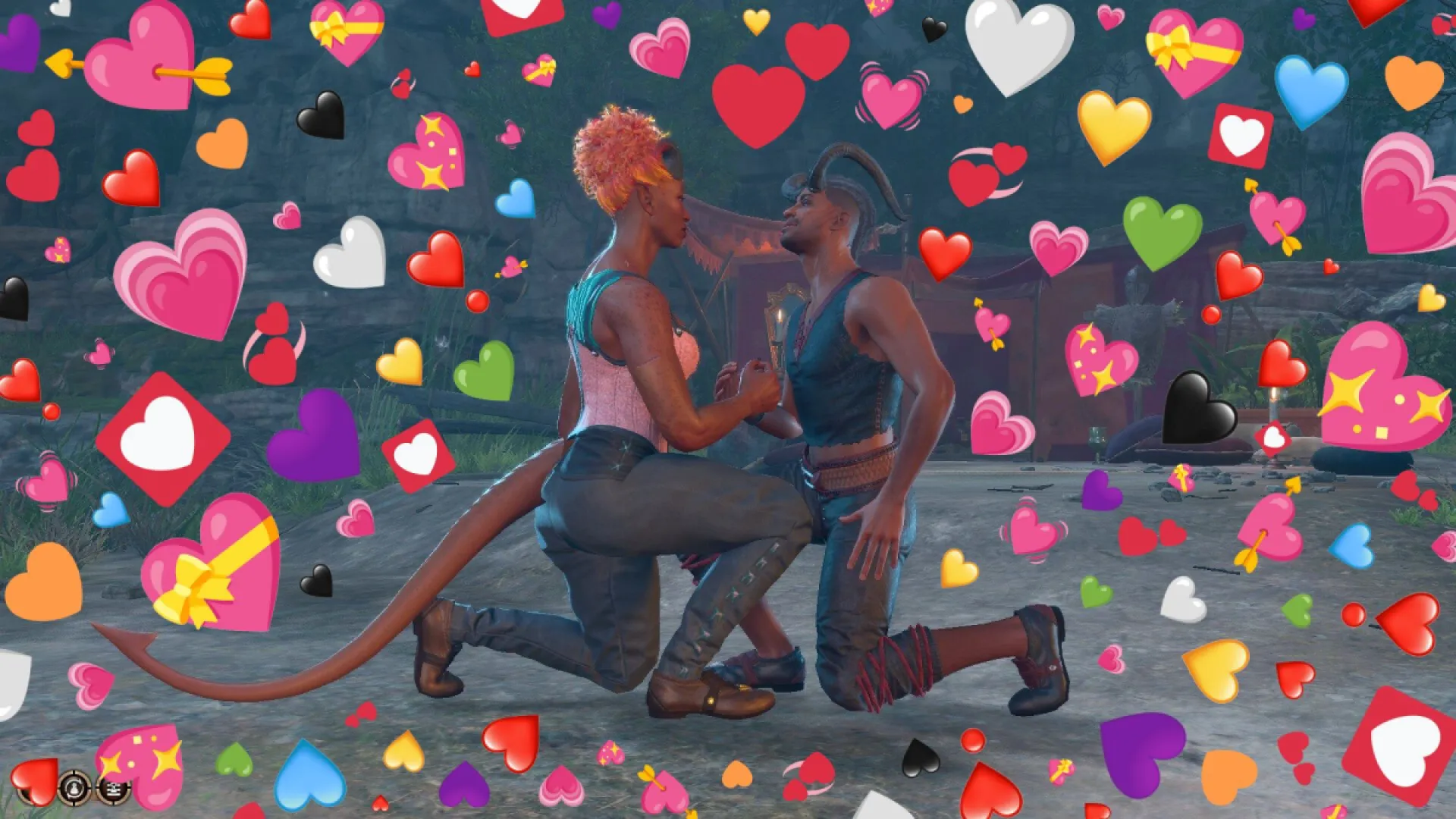
Even as the BG3 community stays fairly welcoming of expressions of sexuality and gender, it continues to skate around racism. Based fandom’s response to Wyll, I have complicated feelings about the direction Larian took with Karlach. From concept design to BG3′s release, there was a clear direction towards deracializing the Tiefling. This sucks on so many levels.
At the same time, I look at how Wyll, his actor (Theo Solomon), and Black (and POC) fans are treated online and feel this uneasy relief about Karlach—relief that Béart and others fans were spared from that inevitable fury that would follow a AAA game with more than a single main character of color.
Karlach in Early Access

If your gut reaction is that Tieflings can’t be a POC because “they’re red,” you aren’t ready for this convo.
The earliest images of Karlach—what we’ll call EA Karlach for Early Access—showed her with clearly “Black” physical features. There’s no one way to “look” Black obviously, but there are common markers. EA Karlach had bigger lips and a wide set nose nearly identical to the facial model of the Tielfing Cyrus—another refugee from Avernus. Developers styled her hair (locs, associated with Black hair textures) into a faux hawk players could use on their Tavs.
Some may be quick to write this off as her just looking like an average Tiefling. After all, this is now the Asmodeus Tiefling default look in character customization. However, this choice (and others) immediately racialized her as non-white early on.
For one, like the Drow and others races, Tieflings serve as the “other” of D&D lore, which the Baldur’s Gate series is based on. Physical traits and history mirror real peoples like the Roma, Jews, Asians, and diasporic Black people. This has led to a lot of racial stereotypes and tropes were embedded into canon. In the last few years, D&D publisher Wizards of the Coast began to address this by removing things like inherently evil races and other changes.
However, the changes to D&D 5e happened well into BG3 development. At the moment, it feels like the game did a mixed positive response with this. In BG3, Tieflings are still very racialized and NPCs will not let you forget it.
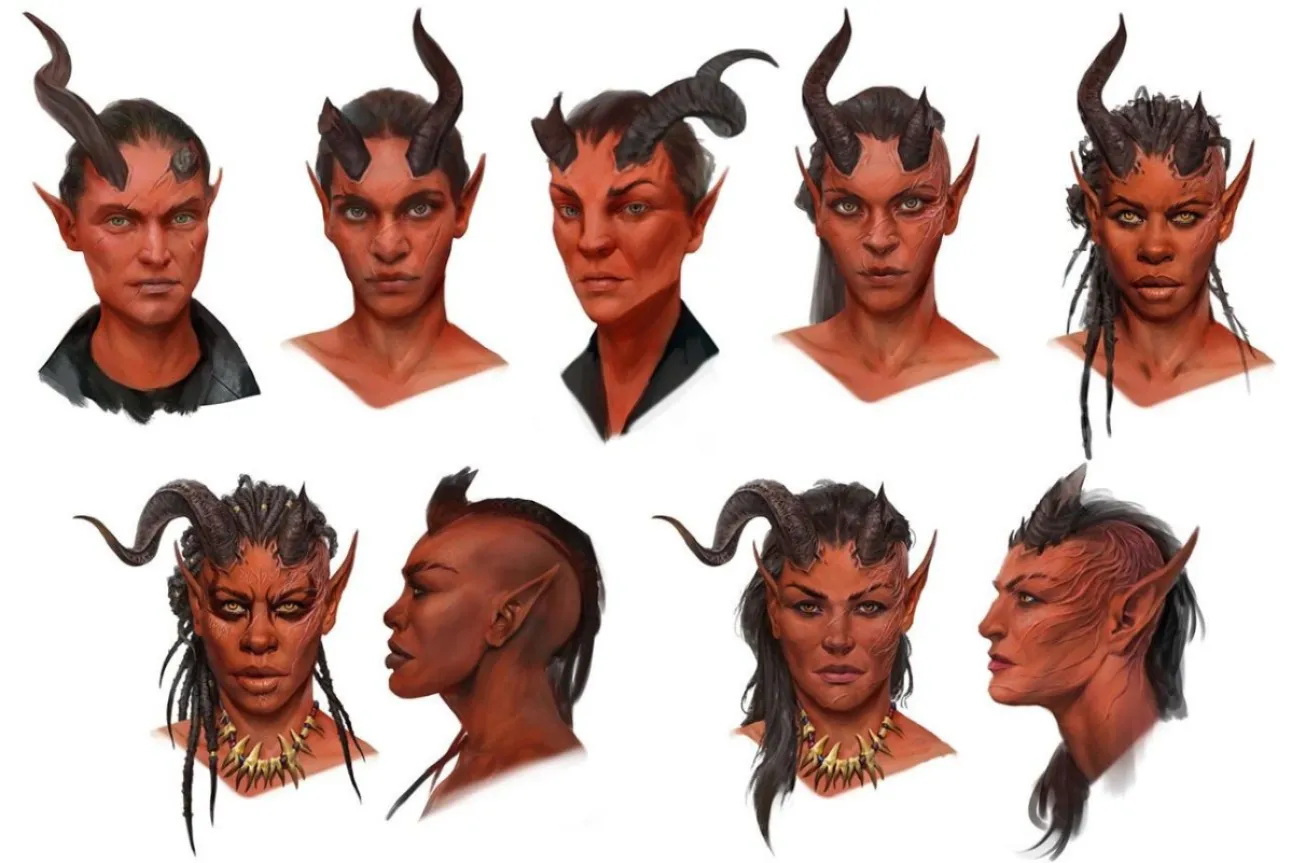
This doesn’t mean Karlach being a Tiefling made her Black or a POC specifically, though. It’s also the concept art that features many faces drawn mostly with phenotypes of Black and Southeast Asian features. Like EA Karlach, many of the sketches feature locs. Another factor is the actor themself. Béart is a Black actor of Jamaican and Irish ancestry. As a Black player, when I saw Béart, even before seeing the early art, I instinctively connected that to Karlach in a way that’s difficult to explain and probably understand unless you’re a person of color, underrepresented in media.
Lots of the Origin characters went through major changes over the course of early access—especially Wyll and Gale. However, Larian worked on Karlach in the background during early access. Until the studio revealed her class right before the game’s release, players viewed her more of a companion like Halsin or Minthara. Because Larian made her model the default Tiefling skin, it’s easy to write it (and its implications) off as a temporary placeholder.
After all, while always a Tiefling, Karlach’s dialogue revealed her to have a broken horn even before the character model reflected this. A few have gone as far as to call this change white-washing. I’m not fully convinced this is 100% applicable. However, when major Black (coded or otherwise) characters are so rare in games like this, it’s hard to shake off and for it to not feel like something was lost.
Trying to rationalize the change

In looking for reasoning for why Larian would give her more white features in the final game, I can’t help but wonder if it was because of her class because that would have its own racial implications. “Barbarian” comes from the Greek word “bárbaros,” meaning not Greek or a foreigner. The English word has referred to people who aren’t white (or white enough) for centuries. Leaders and pundits still use the descriptor to justify violence by dehumanizing large groups of people. Like the words “uncivilized” and “savage,” it’s almost exclusively aimed towards Black and brown people. So, this may have influenced the decision to deracialize her.
Another class-related reason could be the optics of having the sole Black woman lead be masculine. Black women come in all shapes and sizes, however in the media we often fall into three racist tropes. That is, the very sexualized jezebel, the desexualized mammy, and the angry woman. The latter wouldn’t quite apply to Karlach because while her temperature rises, she’s a teddy bear. However, the world still perceives Karlach as monstrous and aggressive for her stature, class, and race (Tiefling). Additionally, the angry Black woman trope tends to lean into masculinization as an insult. Maybe the game designers clocked issues and sought to avoid this altogether.
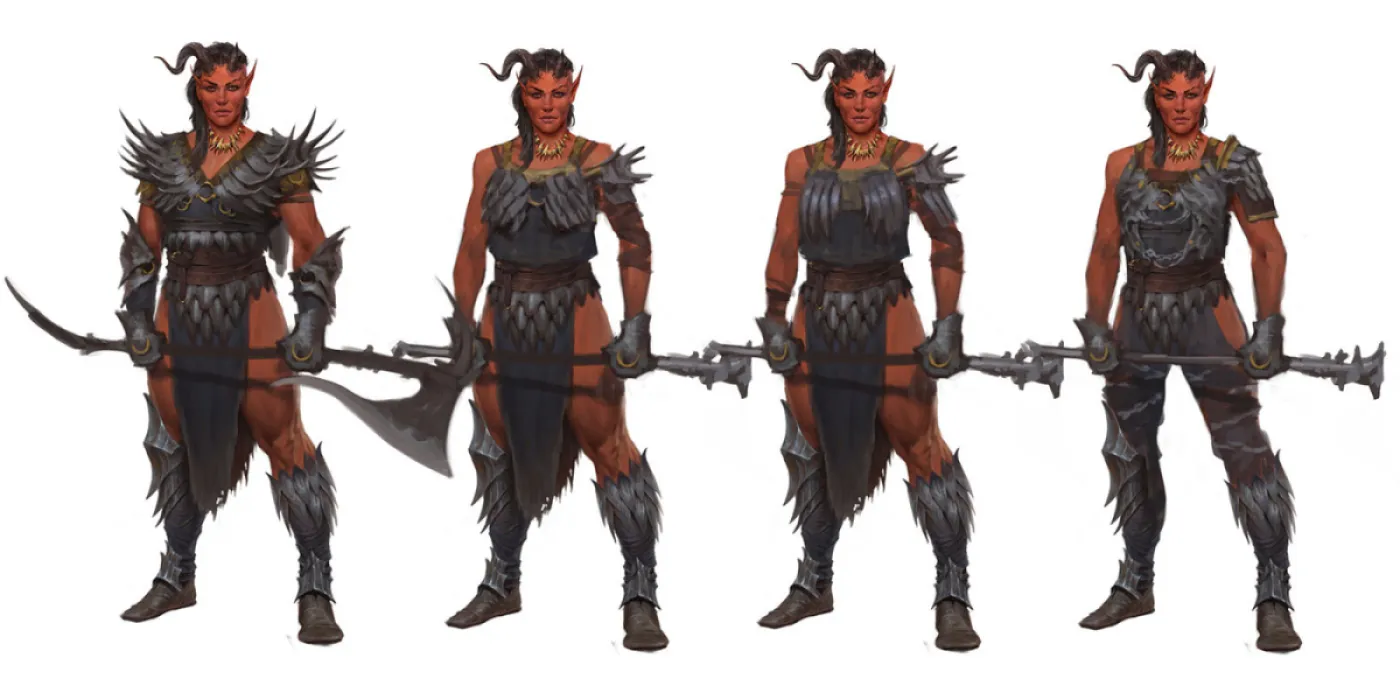
Finally, I considered that they might view Karlach’s story, as an enslaved soldier used for her fighting prowess—her natural talents—as problematic? Maybe … probably. I’m really not looking for a problem, just for answers. She’s not the only Origin character with a history enslavement. Astarion was a slave of Cazador, branded, too. While never enslaved herself, Lae’zel comes from a people (the Gith) who hunt down their former enslavers—the mind flayers. She may have never been one, but that emancipation history makes her who she is. This could and probably does sound like a reach to many people.
They could’ve simply just changed her because they were never firm on what she looked like. I don’t buy this for a few reasons. Thanks to several historical legacies (and unconscious bias), to include a Black character is a conscious decision in most circumstances. More than that, I understand Larian put a lot of care and thought into nearly every aspect of this game. I’ve written so as much for months—even in my slight to major criticisms. This care extends to writing races real and fictional.
There’s disagreement among POC players about how racism was handled. Still, regardless of opinion, it’s clear to many of us that the writers put thought and care into not just the world, but the diversity of players who would find their game. Origin character-wise, each was assigned a writer and the game we got at publication was not the same one from Early Access. Except, maybe Shadowheart and Astarion because they didn’t change too much.
Reactions from fans and Béart
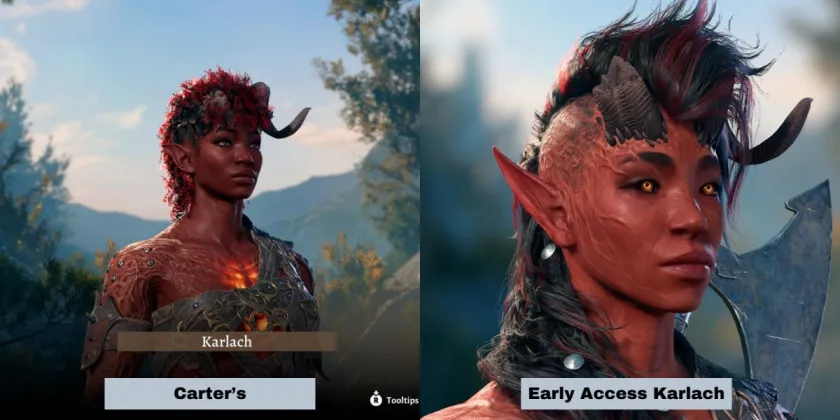
I’m in the minority of fans that see this, or at least are speaking about it online. That’s part of the reason I’ve mulled over this for so long. Regardless, responses from players show a desire for a more explicitly Black Karlach. For example, modder Tepkunset uploaded a Karlach model that gave her features reflective of the early access version. Then, in response to the racist modder that made Wyll white, Alanté Carter created a mod turning all the characters Black. Béart even shared this on Twitter with praise.
On October 27, Tepkunset commented on her race in an update:
… some folks said that her Full Release appearance had East Asian eyes and that it was wrong for me to change that. I can’t say I suddenly agree that Larian replacing a Black character with an Asian character was okay, but now this mod restores her Black features without getting rid of her eye shape […] because of the extreme racism in the comments left on the original version of this mod, I still plan on leaving the comments off. I just don’t have the energy to screen them.
Outside of the praise for Carter’s mod turning all the Origin characters Black, Béart hasn’t made any comments about Karlach’s race. They’re not one to shy away from these discussions, either. Béart continues to speak openly about racism in the entertainment industry and push back against colorism. However, Béart does reject questions about writing and design changes from fans, even hypothetical ones. They feel their role as a performer is to be as a vessel for someone else’s work.
Béart says as much in livestreams when fans ask about their thoughts on the writing and design of Karlach. Across hours and hours of Q&As and interviews, I’ve never seen them asked about this. Because Béart holds this ethos (and also wants to work again), I’m not sure they would express issues with these questions around race and Karlach if they did have them. We just don’t know.
Racism in the fandom and guilty thoughts of relief
Regardless of why Larian changed Karlach, a small part of me wonders if this was for the better? After all, not only does the fandom largely ignore and whitewash the only explicitly Black Origin character (Wyll), but people made a mod to make him white less than a month of the game’s release. Nexus may have removed it, but the racist that made that was welcomed on other sites. Thankfully, Béart’s only shared that the racism they’ve seen is related to BG3 came from that awful Wyll mod. I wish I could say the same.
Unfortunately, the vitriol towards Black women in nerd spaces remain very potent and widespread. The characters (and their actors) get misogynoir hurled at them and the fans that choose to participate in cosplay or fan art get it, too.
Beyond Hogwarts Legacy’s relationship to transphobia, the biggest backlash to a major game in 2023 was not a broken Bethesda game, but Forspoken. The RPG garnered valid criticism regarding the gameplay and how Square Enix handled its Black lead, Frey. And yet, since the first trailer dropped, the wave of racism and sexism made it difficult to differentiate between good and bath faith critiques.
A major criticism of Frey was how her self-aware and quippy nature was too modern even for the low fantasy setting. Within the first two weeks of BG3′s release, a now-waning minority of players voiced similar criticism to Karlach’s voice/dialogue. Without spoiling it, some players even found that this self-awareness can peak. These same qualities are why people love her.
I honestly have no idea if Larian intended on keep Karlach coded as non-white or did initially unintentionally. However, I do know for a fact that Béart would face more racism if more people saw Karlach as Black. If more people recognized Béart is Black or a POC, the actor would face more hate. The treatment of Wyll (and Solomon) and lack of fan appreciation would extend unto Karlach/Béart.
The deracializing (possibly “white-washing”) of Karlach combined with the white face people imagine when they hear any U.K. accent—regardless of how diverse the island and commonwealth are—protects Béart. And, to a certain extent, it also protects the POC fans who engage BG3. And for that I feel guilty that in these reflections over the past few months I feel a bit of twisted relief.
(featured image: Larian Studios, Wizards of the Coast and Jared Blando remixed by Alyssa Shotwell)



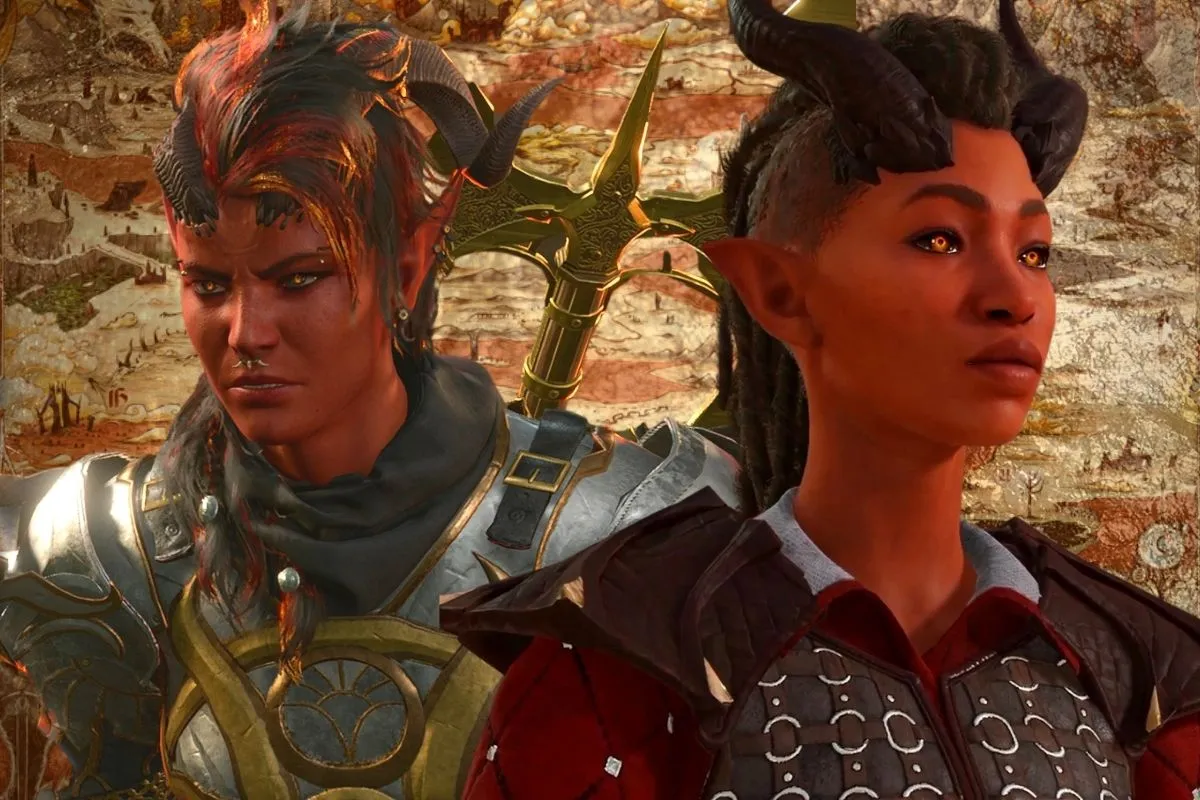






Published: Nov 21, 2023 11:11 am